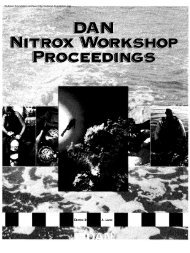Report on Decompression Illness, Diving Fatalities and Project Dive
Report on Decompression Illness, Diving Fatalities and Project Dive
Report on Decompression Illness, Diving Fatalities and Project Dive
- No tags were found...
You also want an ePaper? Increase the reach of your titles
YUMPU automatically turns print PDFs into web optimized ePapers that Google loves.
Secti<strong>on</strong> 6 - Breath-Holding IncidentsIn this review, we will summarize the known data <strong>and</strong> describe thecomm<strong>on</strong> hazard patterns that appear in the records. The casereports found in Appendix C will provide brief summaries of documentedinformati<strong>on</strong>. The reader will be left to interpret these cases– hopefully with critical c<strong>on</strong>siderati<strong>on</strong> of his or her own practices.6.2 Available RecordsThe available records for 1994-2004 incidents were augmentedthrough internet searches <strong>and</strong> reviewed. A total of 172 separate incidentswere referred to in the files. Cases were excluded from thisreview if some written record c<strong>on</strong>firming the actual date of theevent could not be found, or if the reported event occurred outsideof North America <strong>and</strong> the available informati<strong>on</strong> was too limited tobe evaluated (note: future data collecti<strong>on</strong> will likely focus <strong>on</strong> eventsoccurring within North America <strong>and</strong> the Caribbean regi<strong>on</strong>).One hundred forty-five cases were included in this summary.Comprehensive records were generally available for <strong>on</strong>ly rare highprofile events. Virtually all of the reported cases (98 percent, n=142)involved fatalities. The three injury cases included two sharkattacks <strong>and</strong> <strong>on</strong>e near drowning.Incidents were reported in 19 different countries. Seventy-five percent(n=108) occurred in the United States. Ninety percent of theU.S. incidents occurred in three states: Hawaii (34 percent; n=37),Florida (31 percent; n=34) <strong>and</strong> California (24 percent; n=26). Thec<strong>on</strong>centrati<strong>on</strong> <strong>on</strong> U.S. incidents reflects the limited focus of theavailable reports rather than a true worldwide pattern. The distributi<strong>on</strong>of U.S. incidents does reflect the popularity of breath-holdactivities in certain states. It is also possible, however, that the popularityof diving in specific areas has produced a greater awarenessof DAN’s effort in incident data collecti<strong>on</strong> <strong>and</strong> a submissi<strong>on</strong> of morecases. This could c<strong>on</strong>tribute to an overrepresentati<strong>on</strong> of theseregi<strong>on</strong>s.Categorical descripti<strong>on</strong>s of the primary activity of the incident victimwere available in 67 percent of the cases (n=97). The categoriesof the known cases can be seen in Figure 6.2-1. Snorkeling is thebroadest category, including any<strong>on</strong>e wearing mask, snorkel <strong>and</strong> fins(but with no additi<strong>on</strong>al air supply) in the water. Snorkelers mayremain completely <strong>on</strong> the surface or participate in some breath-holddiving from the surface. Freedivers typically wear a mask <strong>and</strong> someform of fin or fins <strong>on</strong>ly <strong>and</strong> direct their activity to breath-hold div-92DAN’s <str<strong>on</strong>g>Report</str<strong>on</strong>g> <strong>on</strong> Decompressi<strong>on</strong> <strong>Illness</strong>, <strong>Diving</strong> <strong>Fatalities</strong> <strong>and</strong> <strong>Project</strong> <strong>Dive</strong> Explorati<strong>on</strong>: 2005 Editi<strong>on</strong>
















